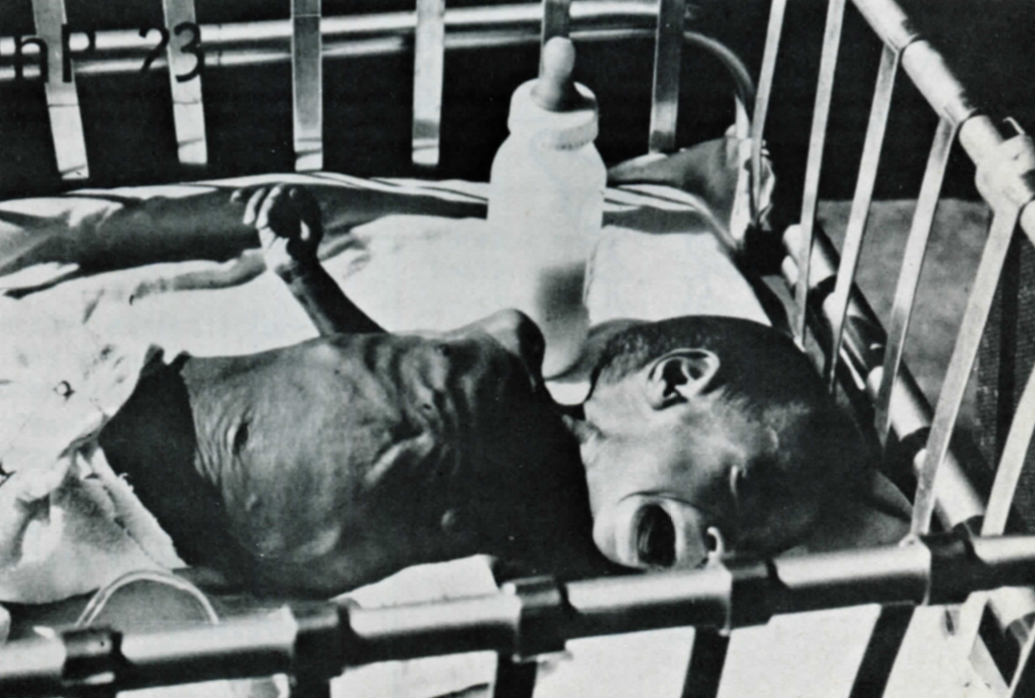What is infant malnutrition?
What is special about human milk?
How does breast milk help the economy of developing countries?
infant malnutrition: what is it?
BIRTH
Weaned under 6 months
Fed on: artificial foods in insufficient quantities and in unhygienic conditions
Diarrheal disease
Protein-energy malnutrition
Weaned at 12-24 months
Fed on: regular family diet often unsuitable for child without teeth, thus leading to exclusive carbohydrate in take
Infection (e.g. measles)
Protein-energy malnutrition
Both conditions of malnutrition are due to an insufficiency of protein and calories, and are characterised by severe weight loss. This condition is also called protein-calorie malnutrition (PCM).
If there is a total lack of food, the result will be marasmus. If the person gets enough energy, but not enough protein, the result will be kwashiorkor. This is extremely rare in adults.
One infant food company says:* "Kwashiorkor is more typical of the rural populations of the world where children are breast fed sometimes up to two years or more, moving directly onto the family diet which is rich in carbohydrates." This makes it seem that breast feeding is responsible for this condition.
BUT IN FACT "Breast feeding is the traditional and ideal form of infant nutrition, usually capable of meeting a child's nutritional needs for his first four to six months of life. Even after the essential introduction of supplemental foods, human milk can serve as an important continuing source of a child's nutritional well-being. From the sixth to the twelfth month it can supply up to three-quarters of a child's protein needs and a significant portion for some months beyond.
"For most infants in low-income countries prolonged breast feeding is vitally necessary to growth and, quite often, survival, as it represents the only easily available source of protein of good quality containing all the essential amino acids." from The Nutrition Factor, by Allan Berg, Brooking Institute, USA, 1973.
*Nestle
Protein-Calorie Malnutrition
Malnutrition has its greatest effect on physiologically vulnerable groups, especially young children who make up over 10 percent of the world's population.
In resource-poor, technically less developed countries, Protein-calorie malnutrition (PCM) of early childhood i s widespread. Severe syndromes, such as kwashiorkor and marasmus, are found in 1 to 7 percent of some populations of young children, while up to two-thirds may be affected by less severe but nevertheless debilitating forms.
PCM is the world's dominant nutritional problem, often associated with deficiencies of other nutrients such as vitamin A. It has been estimated that there are about 10 to 20 million young children with severe syndromes of kwashiorkor or marasmus at any one time - most of whom will die without treatment.
With deterioration of the economic, social or agricultural situation, the numbers affected rise, particularly if famine conditions develop.
HOW BOTTLE FEEDING CAUSES DIARRHEA, MALNUTRITION AND DEATH
Economic Factors
The purchase of packaged milk formula requires CASH. The decision to switch from breast feeding to the bottle is seldom made with a full appreciation of the amount of money needed to sustain this financial outlay over the many months a child requires this kind of nutrition. Inevitably the cash available to the mother falls short of the need for such continued purchases. The most common result is that each purchase of formula is made to stretch by adding greater amounts of water. Very quickly the thinned-out "milk" is too dilute and seriously inadequate in nutrition. During those times when family cash cannot be spared for these products, the bottle simply gets filled with rice pap or thin gruel made from cereal grains. Grave malnutrition in these circumstances is a sure consequence. Too often the money problem leads a frustrated father or family to decide that buying these expensive products must stop after just a few weeks. By then, lactation has long since ceased and this "alternative " no longer exists.

Other factors complicate the preparation of the formula in proper concentration. These include a poor understanding of the means of preparation and a lack of appreciation of the need for careful measurements, often complicated by illiteracy of the mother.
Hygienic Factors
The most important factor here is care of the bottle and nipple ( teat ). The concepts of handling bottle feeding did not exist in the cultures of most developing countries before this generation. Moreover, the kitchen capability to adequately clean these deep and narrow-necked bottles is just not there. And there is no appreciation of the results of contamination or residual spoiled milk.
As a result, an accumulation of residual milk coats the bottom of the bottle, inside the neck of the bottle and inside the nipple. This provides a rich medium for the growth of hosts of bacteria, including some of those capable of inducing devastating gastroenteritis (diarrhea and vomiting). Many of the bottles available in the markets are of cheap plastic with rough and porous surface, which makes them more difficult to clean. Each new preparation of formula added to the bottle is immediately contaminated. The heat in these tropical countries merely speeds the proliferation of bacteria.
The sources of the bacterial contamination are everywhere, on hands, flies, the earth, and, not least of all, the water used to prepare the artificial milk.
All these factors and more contribute to the repeated cycle of malnutrition, increased vulnerability , diarrhea, infections and so on.
The fatal end result is inescapable for many.
(Dr. Stuart J. Kingma, Christian Medical Commission, World Council of Churches; a piece prepared specially for inclusion in this guide)
Although exact figures are hard to come by, it is estimated that only about 5% of the world's women cannot breast feed for physiological reasons.

